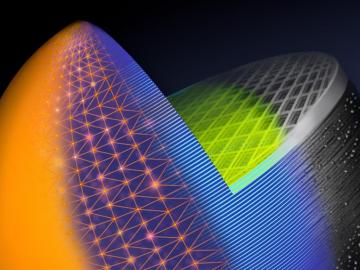
Filter News
Area of Research
News Topics
- (-) 3-D Printing/Advanced Manufacturing (38)
- (-) Statistics (1)
- (-) Sustainable Energy (44)
- Advanced Reactors (8)
- Artificial Intelligence (46)
- Big Data (23)
- Bioenergy (51)
- Biology (59)
- Biomedical (28)
- Biotechnology (11)
- Buildings (19)
- Chemical Sciences (23)
- Clean Water (14)
- Climate Change (49)
- Composites (6)
- Computer Science (82)
- Coronavirus (17)
- Critical Materials (2)
- Cybersecurity (14)
- Decarbonization (46)
- Education (1)
- Emergency (2)
- Energy Storage (28)
- Environment (103)
- Exascale Computing (25)
- Fossil Energy (4)
- Frontier (24)
- Fusion (30)
- Grid (23)
- High-Performance Computing (43)
- Hydropower (5)
- Isotopes (27)
- ITER (2)
- Machine Learning (22)
- Materials (43)
- Materials Science (45)
- Mathematics (6)
- Mercury (7)
- Microelectronics (2)
- Microscopy (20)
- Molten Salt (1)
- Nanotechnology (16)
- National Security (35)
- Net Zero (8)
- Neutron Science (47)
- Nuclear Energy (54)
- Partnerships (16)
- Physics (28)
- Polymers (8)
- Quantum Computing (20)
- Quantum Science (30)
- Renewable Energy (1)
- Security (11)
- Simulation (30)
- Software (1)
- Space Exploration (12)
- Summit (30)
- Transformational Challenge Reactor (3)
- Transportation (27)
Media Contacts

Advanced materials research to enable energy-efficient, cost-competitive and environmentally friendly technologies for the United States and Japan is the goal of a memorandum of understanding, or MOU, between the Department of Energy’s Oak Ridge National Laboratory and Japan’s National Institute of Materials Science.

Researchers at ORNL have developed the first additive manufacturing slicing computer application to simultaneously speed and simplify digital conversion of accurate, large-format three-dimensional parts in a factory production setting.

When Oak Ridge National Laboratory's science mission takes staff off-campus, the lab’s safety principles follow. That’s true even in the high mountain passes of Washington and Oregon, where ORNL scientists are tracking a tree species — and where wildfires have become more frequent and widespread.

Building innovations from ORNL will be on display in Washington, D.C. on the National Mall June 7 to June 9, 2024, during the U.S. Department of Housing and Urban Development’s Innovation Housing Showcase. For the first time, ORNL’s real-time building evaluator was demonstrated outside of a laboratory setting and deployed for building construction.

Momentum for manufacturing innovation in the United States got a boost during the inaugural MDF Innovation Days, held recently at the U.S. Department of Energy Manufacturing Demonstration Facility at Oak Ridge National Laboratory.

ORNL researchers have teamed up with other national labs to develop a free platform called Open Energy Data Initiative Solar Systems Integration Data and Modeling to better analyze the behavior of electric grids incorporating many solar projects.

ORNL scientists contributed to a DOE technical study that found transitioning coal plants to nuclear power plants would create high-paying jobs at the converted plants and hundreds of new jobs locally.

Scientists at the Department of Energy’s Oak Ridge National Laboratory have developed lubricant additives that protect both water turbine equipment and the surrounding environment.

The U.S. Environmental Protection Agency has approved the registration and use of a renewable gasoline blendstock developed by Vertimass LLC and ORNL that can significantly reduce the emissions profile of vehicles when added to conventional fuels.

Scientists at Oak Ridge National Laboratory and six other Department of Energy national laboratories have developed a United States-based perspective for achieving net-zero carbon emissions.


